初中英语时态一般现在时-现在进行时-一般过去时-过去进行时
- 格式:doc
- 大小:72.50 KB
- 文档页数:19
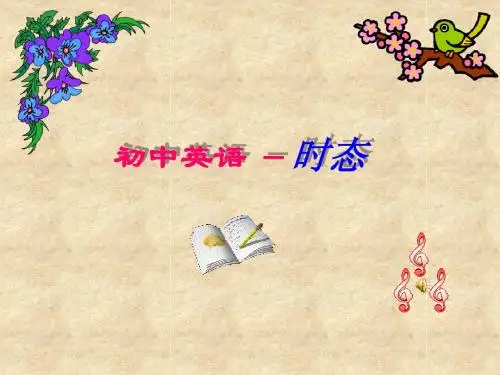
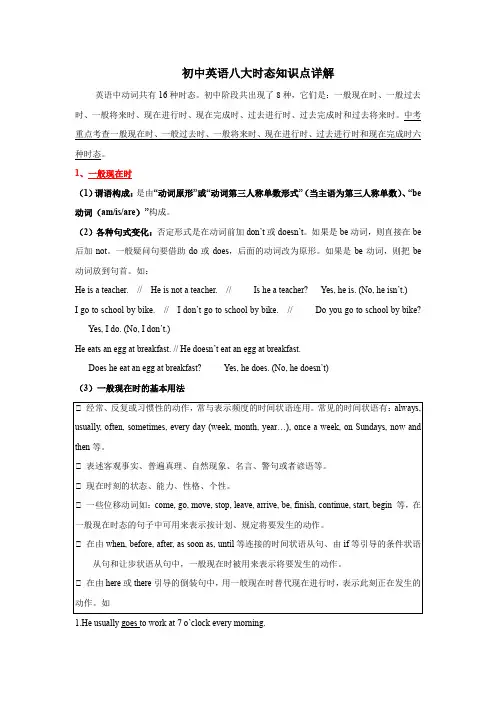
初中英语八大时态知识点详解英语中动词共有16种时态。
初中阶段共出现了8种,它们是:一般现在时、一般过去时、一般将来时、现在进行时、现在完成时、过去进行时、过去完成时和过去将来时。
中考重点考查一般现在时、一般过去时、一般将来时、现在进行时、过去进行时和现在完成时六种时态。
1、一般现在时(1)谓语构成:是由“动词原形”或“动词第三人称单数形式”(当主语为第三人称单数)、“be 动词(am/is/are)”构成。
(2)各种句式变化:否定形式是在动词前加don’t或doesn’t。
如果是be动词,则直接在be 后加not。
一般疑问句要借助do或does,后面的动词改为原形。
如果是be动词,则把be 动词放到句首。
如:He is a teacher. // He is not a teacher. // ---- Is he a teacher? --- Yes, he is. (No, he isn’t.)I go to school by bike. // I don’t go to school by bike. // ---- Do you go to school by bike? ---- Yes, I do. (No, I don’t.)He eats an egg at breakfast. // He doesn’t eat an egg at breakfast.---- Does he eat an egg at breakfast? ---- Yes, he does. (No, he doesn’t)(3)一般现在时的基本用法1.He usually goes to work at 7 o’clock every morning.2.Every dog has its day. 凡人皆有得意日。
3.Pride goes before a fall. 骄者必败。
4.The earth goes around the sun. 地球绕着太阳转。
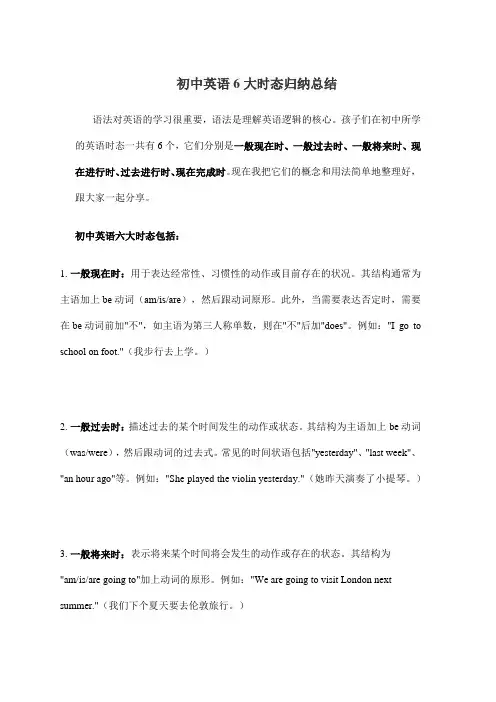
初中英语6大时态归纳总结语法对英语的学习很重要,语法是理解英语逻辑的核心。
孩子们在初中所学的英语时态一共有6个,它们分别是一般现在时、一般过去时、一般将来时、现在进行时、过去进行时、现在完成时。
现在我把它们的概念和用法简单地整理好,跟大家一起分享。
初中英语六大时态包括:1.一般现在时:用于表达经常性、习惯性的动作或目前存在的状况。
其结构通常为主语加上be动词(am/is/are),然后跟动词原形。
此外,当需要表达否定时,需要在be动词前加"不",如主语为第三人称单数,则在"不"后加"does"。
例如:"I go to school on foot."(我步行去上学。
)2.一般过去时:描述过去的某个时间发生的动作或状态。
其结构为主语加上be动词(was/were),然后跟动词的过去式。
常见的时间状语包括"yesterday"、"last week"、"an hour ago"等。
例如:"She played the violin yesterday."(她昨天演奏了小提琴。
)3.一般将来时:表示将来某个时间将会发生的动作或存在的状态。
其结构为"am/is/are going to"加上动词的原形。
例如:"We are going to visit London next summer."(我们下个夏天要去伦敦旅行。
)4.现在进行时:表示现阶段或说话时正在进行的动作及行为。
其结构为主语加上助动词"be"(am/are/is)加上动词的-ing形式。
例如:"She is listening to music."(她在听音乐。
)5.过去进行时:主要用来表示过去某一时刻或一段时间正在进行的动作或者存在的状态。
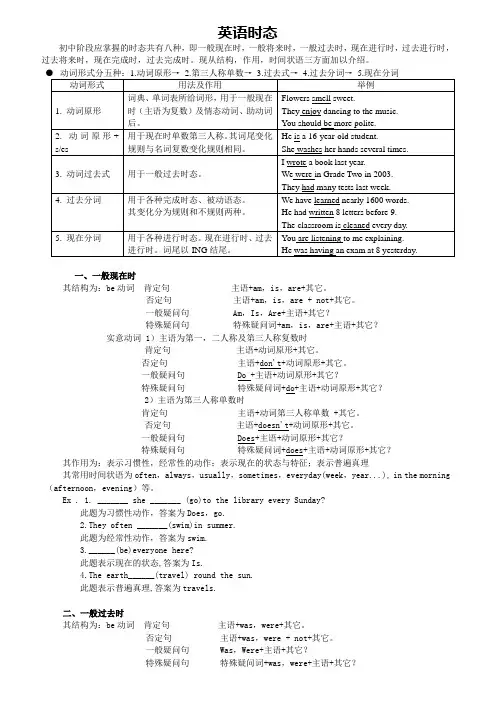
英语时态初中阶段应掌握的时态共有八种,即一般现在时,一般将来时,一般过去时,现在进行时,过去进行时,过去将来时,现在完成时,过去完成时。
现从结构,作用,时间状语三方面加以介绍。
一、一般现在时其结构为:be动词肯定句主语+am,is,are+其它。
否定句主语+am,is,are + not+其它。
一般疑问句 Am,Is,Are+主语+其它?特殊疑问句特殊疑问词+am,is,are+主语+其它?实意动词1)主语为第一,二人称及第三人称复数时肯定句主语+动词原形+其它。
否定句主语+don't+动词原形+其它。
一般疑问句 Do +主语+动词原形+其它?特殊疑问句特殊疑问词+do+主语+动词原形+其它?2)主语为第三人称单数时肯定句主语+动词第三人称单数 +其它。
否定句主语+doesn't+动词原形+其它。
一般疑问句 Does+主语+动词原形+其它?特殊疑问句特殊疑问词+does+主语+动词原形+其它?其作用为:表示习惯性,经常性的动作;表示现在的状态与特征;表示普遍真理其常用时间状语为often,always,usually,sometimes,everyday(week,year...), in the morning (afternoon,evening)等。
Ex . 1. _______ she _______ (go)to the library every Sunday?此题为习惯性动作,答案为Does,go.2.They often _______(swim)in summer.此题为经常性动作,答案为swim.3.______(be)everyone here?此题表示现在的状态,答案为Is.4.The earth______(travel) round the sun.此题表示普遍真理,答案为travels.二、一般过去时其结构为:be动词肯定句主语+was,were+其它。
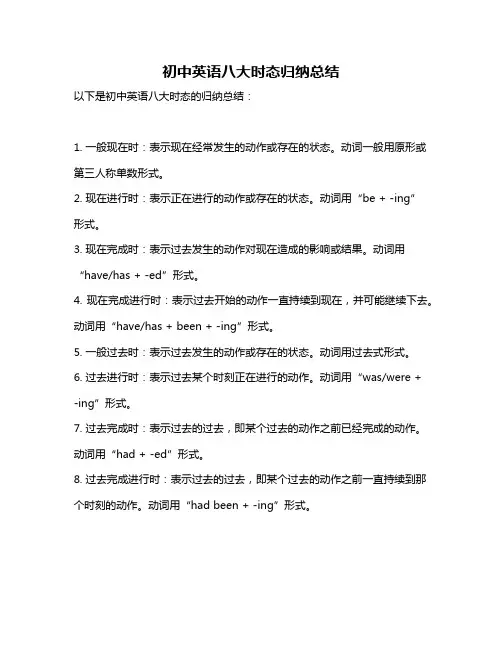
初中英语八大时态归纳总结
以下是初中英语八大时态的归纳总结:
1. 一般现在时:表示现在经常发生的动作或存在的状态。
动词一般用原形或第三人称单数形式。
2. 现在进行时:表示正在进行的动作或存在的状态。
动词用“be + -ing”
形式。
3. 现在完成时:表示过去发生的动作对现在造成的影响或结果。
动词用“have/has + -ed”形式。
4. 现在完成进行时:表示过去开始的动作一直持续到现在,并可能继续下去。
动词用“have/has + been + -ing”形式。
5. 一般过去时:表示过去发生的动作或存在的状态。
动词用过去式形式。
6. 过去进行时:表示过去某个时刻正在进行的动作。
动词用“was/were + -ing”形式。
7. 过去完成时:表示过去的过去,即某个过去的动作之前已经完成的动作。
动词用“had + -ed”形式。
8. 过去完成进行时:表示过去的过去,即某个过去的动作之前一直持续到那个时刻的动作。
动词用“had been + -ing”形式。
以上是初中英语的八大时态,理解和掌握这些时态对于英语学习和交流非常重要。
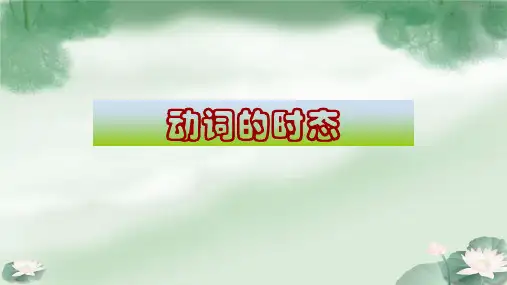
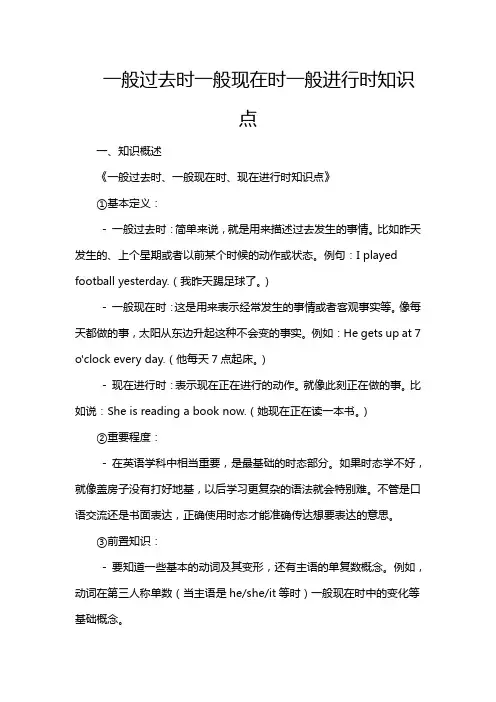
一般过去时一般现在时一般进行时知识点一、知识概述《一般过去时、一般现在时、现在进行时知识点》①基本定义:- 一般过去时:简单来说,就是用来描述过去发生的事情。
比如昨天发生的、上个星期或者以前某个时候的动作或状态。
例句:I played football yesterday.(我昨天踢足球了。
)- 一般现在时:这是用来表示经常发生的事情或者客观事实等。
像每天都做的事,太阳从东边升起这种不会变的事实。
例如:He gets up at 7 o'clock every day.(他每天7点起床。
)- 现在进行时:表示现在正在进行的动作。
就像此刻正在做的事。
比如说:She is reading a book now.(她现在正在读一本书。
)②重要程度:- 在英语学科中相当重要,是最基础的时态部分。
如果时态学不好,就像盖房子没有打好地基,以后学习更复杂的语法就会特别难。
不管是口语交流还是书面表达,正确使用时态才能准确传达想要表达的意思。
③前置知识:- 要知道一些基本的动词及其变形,还有主语的单复数概念。
例如,动词在第三人称单数(当主语是he/she/it等时)一般现在时中的变化等基础概念。
④应用价值:- 在日常生活中很有用。
当你讲过去做了啥,经常做啥和现在正在做啥的时候,就离不开这几个时态。
比如和朋友聊天,介绍自己的日常习惯(一般现在时)、正在做的事情(现在进行时)或者讲以前的经历(一般过去时)。
二、知识体系①知识图谱:- 在英语语法体系里,时态这块儿它们就像基础的砖块。
一般过去时、一般现在时和现在进行时是初步接触时态学的时候的重点部分,后面再学其他时态,像是过去进行时、现在完成时等都会和这几个时态有联系。
②关联知识:- 与词性、句子结构是有联系的。
比如说动词在不同时态下的变化就和动词的词性有很大关系。
同时在复杂句子结构中要正确选择合适的时态才能保证整个句子表达合理。
③重难点分析:- 掌握难度方面,对初学者来说,可能一般现在时在第三人称单数后面动词的变化比较难记,像go变成goes这种。
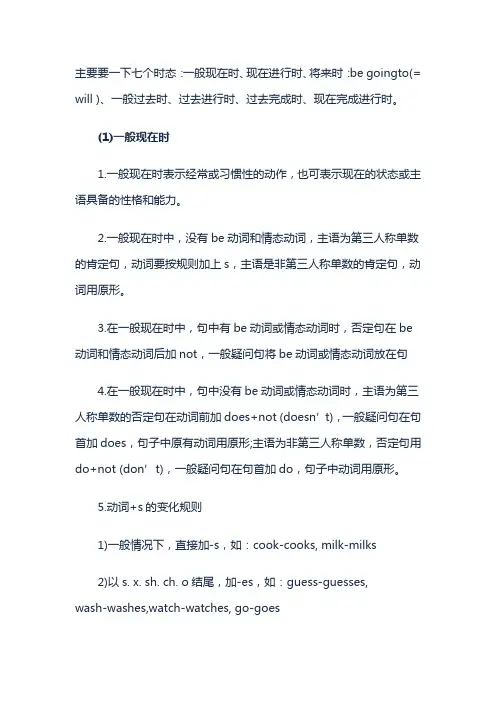
主要要一下七个时态:一般现在时、现在进行时、将来时:be goingto(= will )、一般过去时、过去进行时、过去完成时、现在完成进行时。
(1)一般现在时1.一般现在时表示经常或习惯性的动作,也可表示现在的状态或主语具备的性格和能力。
2.一般现在时中,没有be动词和情态动词,主语为第三人称单数的肯定句,动词要按规则加上s,主语是非第三人称单数的肯定句,动词用原形。
3.在一般现在时中,句中有be动词或情态动词时,否定句在be 动词和情态动词后加not,一般疑问句将be动词或情态动词放在句4.在一般现在时中,句中没有be动词或情态动词时,主语为第三人称单数的否定句在动词前加does+not (doesn’t),一般疑问句在句首加does,句子中原有动词用原形;主语为非第三人称单数,否定句用do+not (don’t),一般疑问句在句首加do,句子中动词用原形。
5.动词+s的变化规则1)一般情况下,直接加-s,如:cook-cooks, milk-milks2)以s. x. sh. ch. o结尾,加-es,如:guess-guesses,wash-washes,watch-watches, go-goes3)以“辅音字母+y”结尾,变y为i, 再加-es,如:study-studies6. 句中be动词和动词一般情况下只能有一种而且也必须有一种。
如:The childrenare very happy on Christmas Day .7.一般现在时中的be动词:一般用原形:am is aream用于第一人称单数(I);is用于第三人称单数(he she it和其他人名或称谓,如:Ben his sister等);are用于第二人称单数(you)和所有复数(包括第一人称复数we、第二人称复数you;第三人称复数they和其他复数,如his parents等)。
8.一般过去时中的动词:有两种情况:第一种情况:主语是第三人称单数(he she it 和其他,如Helen 、her cousin 等),动词后一般加s或es。
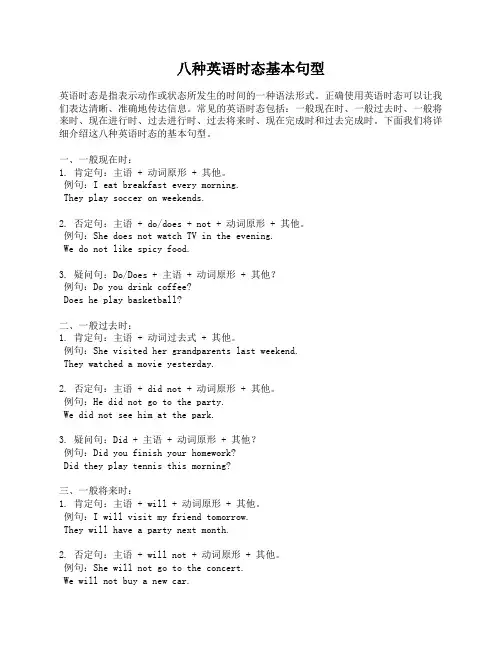
八种英语时态基本句型英语时态是指表示动作或状态所发生的时间的一种语法形式。
正确使用英语时态可以让我们表达清晰、准确地传达信息。
常见的英语时态包括:一般现在时、一般过去时、一般将来时、现在进行时、过去进行时、过去将来时、现在完成时和过去完成时。
下面我们将详细介绍这八种英语时态的基本句型。
一、一般现在时:1. 肯定句:主语 + 动词原形 + 其他。
例句:I eat breakfast every morning.They play soccer on weekends.2. 否定句:主语 + do/does + not + 动词原形 + 其他。
例句:She does not watch TV in the evening.We do not like spicy food.3. 疑问句:Do/Does + 主语 + 动词原形 + 其他?例句:Do you drink coffee?Does he play basketball?二、一般过去时:1. 肯定句:主语 + 动词过去式 + 其他。
例句:She visited her grandparents last weekend.They watched a movie yesterday.2. 否定句:主语 + did not + 动词原形 + 其他。
例句:He did not go to the party.We did not see him at the park.3. 疑问句:Did + 主语 + 动词原形 + 其他?例句:Did you finish your homework?Did they play tennis this morning?三、一般将来时:1. 肯定句:主语 + will + 动词原形 + 其他。
例句:I will visit my friend tomorrow.They will have a party next month.2. 否定句:主语 + will not + 动词原形 + 其他。
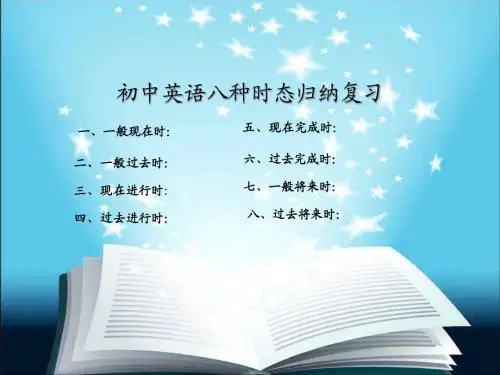
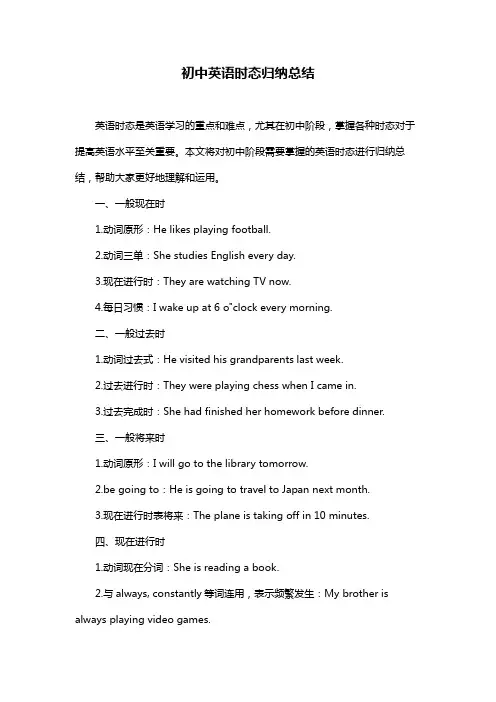
初中英语时态归纳总结英语时态是英语学习的重点和难点,尤其在初中阶段,掌握各种时态对于提高英语水平至关重要。
本文将对初中阶段需要掌握的英语时态进行归纳总结,帮助大家更好地理解和运用。
一、一般现在时1.动词原形:He likes playing football.2.动词三单:She studies English every day.3.现在进行时:They are watching TV now.4.每日习惯:I wake up at 6 o"clock every morning.二、一般过去时1.动词过去式:He visited his grandparents last week.2.过去进行时:They were playing chess when I came in.3.过去完成时:She had finished her homework before dinner.三、一般将来时1.动词原形:I will go to the library tomorrow.2.be going to:He is going to travel to Japan next month.3.现在进行时表将来:The plane is taking off in 10 minutes.四、现在进行时1.动词现在分词:She is reading a book.2.与always, constantly等词连用,表示频繁发生:My brother is always playing video games.五、过去进行时1.动词过去分词:They were discussing the project.2.与at that time, at this moment等词连用,表示在某个时间正在进行的动作:At that time, she was sleeping.六、完成时1.现在完成时:I have finished my homework.2.过去完成时:He had left the classroom before I arrived.七、被动语态1.一般现在时:The book is written by him.2.一般过去时:The window was broken by Tom.3.一般将来时:The letter will be sent to her tomorrow.总结:初中英语时态的学习需要掌握一般现在时、一般过去时、一般将来时、现在进行时、过去进行时、完成时和被动语态等。
初中英语八大时态初中英语学习中,时态是一个重要的语法知识点。
初中英语中的时态有八种,分别是一般现在时、一般过去时、一般将来时、现在进行时、现在完成时、过去进行时、过去完成时和将来进行时。
一般现在时一般现在时表示现在的状态或动作,一般现在时的句子要用动词的一般形式,如:He studies English every day. 他每天学习英语。
一般过去时一般过去时表示过去的状态或动作,一般过去时的句子要用动词过去式,如:He studied English yesterday. 他昨天学习英语。
一般将来时一般将来时表示将来的状态或动作,一般将来时的句子要用动词将来式,如:He will study English tomorrow. 他明天要学习英语。
现在进行时现在进行时表示正在进行的动作,句子中要用动词的现在分词,如:He is studying English now. 他现在正在学习英语。
现在完成时现在完成时表示过去某一时间开始到现在为止的动作,句子中要用助动词have/has + 过去分词,如:He has studied English for two years. 他已经学习英语两年了。
过去进行时过去进行时表示过去正在进行的动作,句子中要用助动词was/were + 现在分词,如:He was studying English at this time yesterday. 他昨天这个时候正在学习英语。
过去完成时过去完成时表示过去的动作在过去的某一时间之前就已经完成,句子中要用助动词had + 过去分词,如:He had studied English before he came here. 他来这里之前已经学习英语了。
将来进行时将来进行时表示将来正在进行的动作,句子中要用助动词will/shall + be + 现在分词,如:He will be studying English at this time tomorrow. 他明天这个时候将会正在学习英语。
初三英语时态汇总一般现在时【定义】一般现在时表示现在经常反复发生的动作、存在的状态或习惯性的动作。
即描述我们日常生活中的衣食住行等活动。
【用法】(1)在实际应用中,一般现在时常与以下时间状语联用:always, usually, often, sometimes, every week (day, year, month, once a week, on Sundays ……例句:He usually plays football on Sundays.(2)没有时间状语,可以分以下四种类型:A.be型这一类型由be动词+名词、形容词、副词、代词、数词或介词短语等一起构成谓语,表示主语的个性、特征或状态。
如:①I am a student.(主语+be动词+名词)②They are hungry.(主语+be动词+形容词)③He is out.(主语+be动词+副词)④That pen is mine.(主语+be动词+代词)⑤I am fifteen.(主语+be动词+数词)⑥The bike is under the tree.(主语+be动词+介词短语)B.do型do型由行为动词充当谓语,表示经常性或习惯性的动作,其构成为“主语+动词原形或动词第三人称单数形式”。
如:①I know it. ②He believes me.C.there be型there be型句子表示“某地存在…”,其构成为“there be+主语+其他”,表示客观事实。
用法遵循“就近原则”,即主语是单数或并列主语中的第一个主语是单数,则用there is;主语是复数或并列主语中的第一个主语是复数,则用there are。
如:(1)There is an eraser on the teacher's desk.(主语an eraser是单数)(2)There is an orange,five apples and eight bananas in the bag.(并列主语中的第一个主语an orange是单数)D.情态动词型情态动词型句子的构成为“主语+情态动词+动词原形”,情态动词和动词原形一起构成谓语,表示说话人对所叙述的动作或状态的看法。
初中英语动词时态分类和经典例句-CAL-FENGHAI.-(YICAI)-Company One1动词时态【用法讲解】考试要求:英语的动词的时态共有十六种,但是中考常考的主要有八种,一般现在时、一般过去时、一般将来时、现在进行时、现在完成时、过去进行时、过去将来时,过去完成时等时态的构成和用法。
1. 一般现在时一般现在时的构成:一般现在时主要用动词原形表示,如果主语是第三人称单数,一般在动词原形后加-s或-es。
例如:I have breakfast at 7 every morning. 我每天早晨7点吃早餐。
He goes swimming on Sundays. 每周日他都去游泳。
一般现在时的用法:(1)表示经常发生的动作或者经常存在的状态。
经常和表示时间的状语often,always,usually,sometimes,every day等连用。
例如:My sister usually goes to school on foot.我姐姐经常步行去上学。
We often come to school at six in the morning.我们经常在早上六点到学校。
(2)表示某种习惯或者能力,也可以表示职业、特征等。
例如:My mother often gets up very early in the morning.我的妈妈经常在早上起床很早。
This kind of car runs very fast.这种小汽车跑得非常快。
(3)表示客观事实、客观规律或者客观真理。
例如:This kind of trees never grows in the desert.这种树从来不在沙漠里生长。
Do you know that knowledge is power你知道知识就是力量吗?(4)在时间、条件、让步等状语从句中,表示将来的动作。
例如:They’ll be so happy when I tell them.我告诉他们时,他们会很高兴的。
初中英语时态8种基本时态结构表全文共四篇示例,供读者参考第一篇示例:初中英语时态是学生学习英语语法中的重要内容。
掌握不同的时态结构是构建正确语法的关键。
英语中共有8种基本时态结构,分别是一般现在时、一般过去时、一般将来时、现在进行时、过去进行时、将来进行时、现在完成时和过去完成时。
下面将对这8种基本时态结构进行详细介绍。
1. 一般现在时(Simple Present Tense)一般现在时表示经常性或习惯性的动作、客观真理或公认事实。
结构:主语+ 动词原形(第三人称单数要加-s/-es)+ 其他。
例如:- He plays basketball every Sunday.(他每个星期天打篮球。
)- The sun rises in the east.(太阳从东方升起。
)8. 过去完成时(Past Perfect Tense)过去完成时表示过去某个时间点之前已经发生的动作。
结构:主语+ had + 过去分词+ 其他。
例如:- They had already left when I arrived.(当我到达时他们已经离开了。
)- She had studied English before she went abroad.(她在出国之前已经学过英语。
)掌握这8种基本时态结构,对于初中生来说是很重要的。
要注意时态的选择和灵活运用,以便更准确、流畅地表达自己的意思。
希望通过学习和练习,同学们能够掌握这些时态,提高自己的英语水平。
第二篇示例:初中英语时态是英语学习中非常重要的一部分,掌握好时态的运用可以帮助我们更好地表达自己的意思,使语言更加清晰和准确。
在英语中,时态可以分为多种类型,其中最基本的就是八种基本时态。
下面我们来详细了解一下这八种基本时态以及它们的结构和用法。
一、一般现在时(Simple Present Tense)一般现在时表示的是经常性或习惯性的动作或状态。
它的结构是主语+动词原形(第三人称单数要加-s)。
一般现在时1. 一般现在时的基本用法:1) 经常性或习惯性的动作,常与表示频率副词的时间状语连用。
时间状语:every morning(afternoon,Sunday), sometimes, on Sunday, often, usually等. 例如:I wake up at six O’clock every morning。
My friends often go to the park on Sundays。
2) 用于表示客观真理,客观存在,科学事实。
例如:The earth moves around the sun。
Tomorrow is Tuesday.3) 用于格言或警句中.例如:Where there is a will,there is a way。
4)用于表示现在时刻的状态、能力、性格、个性。
例如:I don't want so much.She is a good girl and always help others。
My watch is very new。
2。
一般现在时的构成:当主语是第一人称,第二人称或第三人称复数时,谓语动词要用动词原形.当主语是第三人称单数时,谓语动词要用第三人称单数形式,即动词词尾要加s或es。
例. We have four classes in the morning every day。
They work in a big office.She likes singing very much。
附注:动词的第三人称单数变化形式分为规则变化和不规则变化两种形式。
1. 规则变化:(1)直接在动词词尾加-s.ask—--asks work---works get-——gets stay-——stays(2) 以字母s,x,ch, sh或o结尾的动词,在词尾直接加-es.fix-—-fixes do—--does go———goes pass-—-passeswatch——-watches wash____washes(3)以“辅音字母加“y”结尾的动词,要先变y为i再加-es.try-——tries study———studies cry---cries2.不规则变化:be--—- is have-———has3. 一般现在时的句子转换:变否定句、一般疑问句(1)一般疑问句:当句子中有be动词或情态动词时,则把be动词或情态动词提到主语的前面变成疑问句;否定句:在be动词或情态动词后面加not变成否定句.例:She is a student。
I can swim。
→Is she a student? →Can you swim?→She is not a student. →I can not swim。
(2)一般疑问句:当句子中即没有be动词,也没有情态动词时,则在主语前加助动词do, does 变成问句;否定句:在主语后谓语动词前加助动词don’t, doesn’t变成否定句,助动词后的谓语动词要变成动词原形。
例:We get up at 7:00 every morning.→Do you get up at 7:00 every morning?→We don't get up at 7:00 every morning.She has a little brother。
→Does she have a little brother?→She doesn’t have a little brother.百看不如一练一、写出下列动词的第三人称单数形式。
sit swim read make run write type go watch cleancry wash jump come study二、用do、does填空1、_____ you ride a bike after school?Yes, I ________.2、______ your sister like football?No,she ______ not。
3、What_______ the students have?They have some pens。
4、How______ Linda go to school? She goes to school on foot。
5、He ______ not speak English。
He speaks Chinese。
6、______ they watch TV on Sundays?Yes, they ______ 。
7、My father and mother ______ not read newspapers on Saturday。
三、改句子1。
Do you often play football after school? (肯定回答)2。
I have many books. (改为否定句)3. Gao Shan's sister likes playing table tennis (改为否定句)4。
She lives in a small town near New York. (改为一般疑问句)5。
I watch TV every day. (改为一般疑问句)6。
David has got a goal. (改为一般疑问句)7。
We have four lessons。
(否定句)8。
Nancy doesn’t run fast (肯定句)9。
My dog runs fast.否定句:一般疑问句:10. Mike has two letters for him。
一般疑问句:否定句:11。
I usually play football on Friday afternoon。
否定句:一般疑问句:12. Su Yang usually washes some clothes on Saturday.否定句:一般疑问句:13. Mingming usually waters the flowers every day否定句:般疑问句:14。
Tom does his homework at home。
否定句:一般疑问句:现在进行时一、现在进行式的基本结构。
1) 第一人称:主语+ am + 现在分词+ ……I am watching TV。
2)第三人称单数:主语+ is + 现在分词+ ……She is washing the dishes。
3) 第二人称及复数人称:主语+ are + 现在分词+ ……They are playing games。
二、进行时的基本用法:1) 表示现在(指说话人说话时) 正在发生的事情。
We are waiting for you。
2)习惯进行:表示长期的或重复性的动作,说话时动作未必正在进行.Mr。
Green is writing another novel。
She is learning English under Mr。
Smith.3)表示渐变的动词有:get, grow, become,turn, run,go等。
The leaves are turning red.It’s getting warmer and warmer.4) 与always, constantly,forever 等词连用,表示反复发生的动作或持续存在的状态,往往带有说话人的主观色彩。
You are always changing your mind.三、现在进行时谓语动词的变化规则1) 一般情况下,在动词后加ing构成。
如:work_working sleep_sleepingwait_waiting study_studying2)以不发音的e结尾的动词去掉e后再加ing. 如take_taking move_ moving write_writing.3)以重读闭音节或r音节结尾且未尾只有一个辅音字母的动词,要双写未尾的辅音字母于加ing。
如。
sit_sitting plan____planning swim_swimming.4)以字母ie结尾的动词,通常把ie改为y,再加ing.如。
die___dying Lie__lying四、没有进行时态的动词1) 表示感觉的感官动词没有进行时态。
see hear feel sound smell taste2) 表示存在状态的动词没有进行时态have(有) stay be own3)表示人物的心理活动,态度情感等的描述性动词没有进行时态love like hate know think4)表示一次性动作的动词没有进行时态decide give百看不如一练一写出下列动词的现在分词stand_________ sleep_________ jump_________ walk_________ clean_________ wash_________ do____________ go__________ listen_________ read_________ play __________sing__________ have_________ write_________ come_________ dance_________ skate_________ make________ ride__________sit___________ run__________ swim_________二根据提示完成下列句子1。
The students_______ (正在上英语课)2.Some girls________ (正在跳舞)3.I____________ (正在骑自行车)4.My mother__________(正在做家务)5.Helen___________ (会做模型飞机)6.______you____ (正在看报纸吗)7.______she_______(正在打扫图书馆吗)8。
_______the boys________(正在打篮球吗)三、用所给的动词的正确形式填空:1.The boy __________________ ( draw)a picture now。
2。
Listen!Some girls _______________ ( sing)in the classroom 。
3。
My mother _________________ ( cook )some nice food now. 4。
What _____ you ______ (do ) now?5. Look! They _______________( have)an English lesson 。